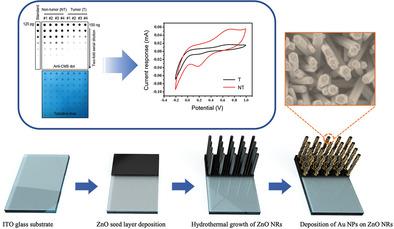当前位置:
X-MOL 学术
›
Adv. Healthcare Mater.
›
论文详情
Our official English website, www.x-mol.net, welcomes your
feedback! (Note: you will need to create a separate account there.)
Rapid and Label-Free Detection of 5-Hydroxymethylcytosine in Genomic DNA Using an Au/ZnO Nanorods Hybrid Nanostructure-Based Electrochemical Sensor
Advanced Healthcare Materials ( IF 10.0 ) Pub Date : 2021-09-23 , DOI: 10.1002/adhm.202101193 Kiesar Sideeq Bhat 1 , Hyejin Kim 2 , Asrar Alam 1 , Myunggon Ko 2 , Jungeun An 3 , Sooman Lim 1
Advanced Healthcare Materials ( IF 10.0 ) Pub Date : 2021-09-23 , DOI: 10.1002/adhm.202101193 Kiesar Sideeq Bhat 1 , Hyejin Kim 2 , Asrar Alam 1 , Myunggon Ko 2 , Jungeun An 3 , Sooman Lim 1
Affiliation

|
Ten-eleven-translocation (TET) proteins modify DNA methylation by oxidizing 5-methylcytosine (5mC) to 5-hydroxymethylcytosine (5hmC). Loss of 5hmC, a widely accepted epigenetic hallmark of cancers, is proposed as a biomarker for early cancer diagnosis and prognosis. Thus, precise quantification of 5hmC holds great potential for diverse clinical applications. DNAs containing 5mC or 5hmC display different adsorption affinity toward the gold surface, thus producing different electrochemical responses. Here a novel, label-free electrochemical sensor based on gold nanoparticles (Au NPs)/zinc oxide nanorods (ZnO NRs) nanostructure for the facile and real-time detection of 5hmC-enriched DNAs is reported. The hybrid structure is fabricated by the vertical hydrothermal growth of ZnO NRs onto indium tin oxide glass substrate, followed by the decoration of ZnO NRs with Au NPs via sputtering. Successful fabrication is confirmed by analyzing the morphology and chemical composition of the sensor. By coupling the fabricated sensor with cyclic voltammetry, its functionality in distinguishing genomic DNAs containing different levels of 5hmC is validated. Notably, the sensor device successfully and consistently detects 5hmC loss in primary hepatocellular carcinoma, compared to the normal tissues. Thus, the novel sensing strategy to assess DNA hydroxymethylation will likely find broad applications in early cancer diagnosis and prognosis evaluation.
中文翻译:

使用基于 Au/ZnO 纳米棒混合纳米结构的电化学传感器快速无标记检测基因组 DNA 中的 5-羟甲基胞嘧啶
十一十一易位 (TET) 蛋白通过将 5-甲基胞嘧啶 (5mC) 氧化为 5-羟甲基胞嘧啶 (5hmC) 来修饰 DNA 甲基化。5hmC 的缺失是一种广泛接受的癌症表观遗传标志,被提议作为早期癌症诊断和预后的生物标志物。因此,5hmC 的精确量化在各种临床应用中具有巨大的潜力。含有 5mC 或 5hmC 的 DNA 对金表面显示出不同的吸附亲和力,从而产生不同的电化学响应。本文报道了一种基于金纳米粒子 (Au NPs)/氧化锌纳米棒 (ZnO NRs) 纳米结构的新型无标记电化学传感器,可轻松实时检测富含 5hmC 的 DNA。通过在氧化铟锡玻璃基板上垂直水热生长 ZnO NRs 来制造混合结构,然后通过溅射用 Au NPs 装饰 ZnO NRs。通过分析传感器的形态和化学成分来确认成功的制造。通过将制造的传感器与循环伏安法相结合,验证了其区分包含不同水平 5hmC 的基因组 DNA 的功能。值得注意的是,与正常组织相比,该传感器装置成功且始终如一地检测到原发性肝细胞癌中 5hmC 的损失。因此,评估 DNA 羟甲基化的新型传感策略可能会在早期癌症诊断和预后评估中得到广泛应用。它在区分含有不同水平 5hmC 的基因组 DNA 方面的功能得到了验证。值得注意的是,与正常组织相比,该传感器装置成功且始终如一地检测到原发性肝细胞癌中 5hmC 的损失。因此,评估 DNA 羟甲基化的新型传感策略可能会在早期癌症诊断和预后评估中得到广泛应用。它在区分含有不同水平 5hmC 的基因组 DNA 方面的功能得到了验证。值得注意的是,与正常组织相比,该传感器装置成功且始终如一地检测到原发性肝细胞癌中 5hmC 的损失。因此,评估 DNA 羟甲基化的新型传感策略可能会在早期癌症诊断和预后评估中得到广泛应用。
更新日期:2021-11-17
中文翻译:

使用基于 Au/ZnO 纳米棒混合纳米结构的电化学传感器快速无标记检测基因组 DNA 中的 5-羟甲基胞嘧啶
十一十一易位 (TET) 蛋白通过将 5-甲基胞嘧啶 (5mC) 氧化为 5-羟甲基胞嘧啶 (5hmC) 来修饰 DNA 甲基化。5hmC 的缺失是一种广泛接受的癌症表观遗传标志,被提议作为早期癌症诊断和预后的生物标志物。因此,5hmC 的精确量化在各种临床应用中具有巨大的潜力。含有 5mC 或 5hmC 的 DNA 对金表面显示出不同的吸附亲和力,从而产生不同的电化学响应。本文报道了一种基于金纳米粒子 (Au NPs)/氧化锌纳米棒 (ZnO NRs) 纳米结构的新型无标记电化学传感器,可轻松实时检测富含 5hmC 的 DNA。通过在氧化铟锡玻璃基板上垂直水热生长 ZnO NRs 来制造混合结构,然后通过溅射用 Au NPs 装饰 ZnO NRs。通过分析传感器的形态和化学成分来确认成功的制造。通过将制造的传感器与循环伏安法相结合,验证了其区分包含不同水平 5hmC 的基因组 DNA 的功能。值得注意的是,与正常组织相比,该传感器装置成功且始终如一地检测到原发性肝细胞癌中 5hmC 的损失。因此,评估 DNA 羟甲基化的新型传感策略可能会在早期癌症诊断和预后评估中得到广泛应用。它在区分含有不同水平 5hmC 的基因组 DNA 方面的功能得到了验证。值得注意的是,与正常组织相比,该传感器装置成功且始终如一地检测到原发性肝细胞癌中 5hmC 的损失。因此,评估 DNA 羟甲基化的新型传感策略可能会在早期癌症诊断和预后评估中得到广泛应用。它在区分含有不同水平 5hmC 的基因组 DNA 方面的功能得到了验证。值得注意的是,与正常组织相比,该传感器装置成功且始终如一地检测到原发性肝细胞癌中 5hmC 的损失。因此,评估 DNA 羟甲基化的新型传感策略可能会在早期癌症诊断和预后评估中得到广泛应用。











































 京公网安备 11010802027423号
京公网安备 11010802027423号